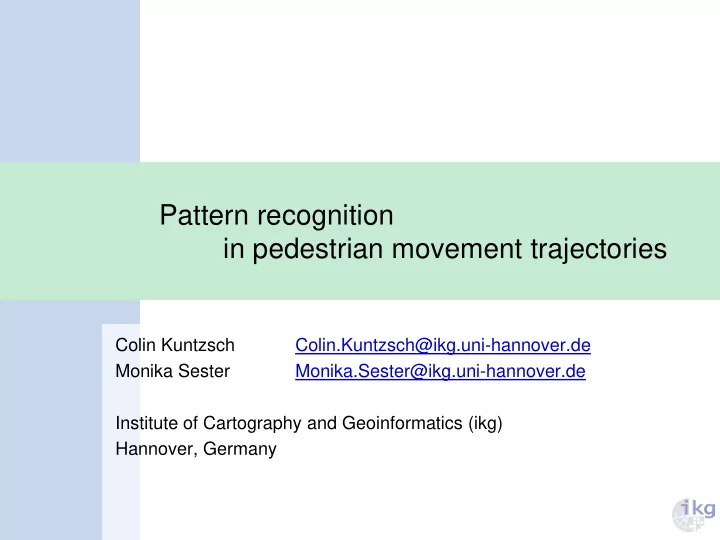

Pattern recognition in pedestrian movement trajectories Colin Kuntzsch Colin.Kuntzsch@ikg.uni-hannover.de Monika Sester Monika.Sester@ikg.uni-hannover.de Institute of Cartography and Geoinformatics (ikg) Hannover, Germany
Overview BMBF project CamInSens Self-organized smart-camera network in a surveillance scenario pattern analysis on trajectory data collaborative camera tracking: generation of 3D-models user interface: visualization of observed anomalous behaviour (large amounts of spatial data) investigation of legal boundary conditions 2
Challenges work with huge amounts of spatially distributed trajectory data real-time processing → need for incremental algorithms deal with limited precision, temporal/spatial resolution, short- term loss of tracking identify anomalous behaviour from small sample sizes build a scene-specific, spatio-temporal model of common behaviour 3
Geometric analysis: trajectory attributes movement prediction position, heading speed matching of unconnected periodic lateral movement: trajectory segments frequency, step length 4
Geometric analysis: trajectory pre-processing reduction of noise from trajectory data separate significant movement from fine-granular movement piece-wise linearization utilizing a corridor width resembling the average width of human pedestrian movement (0.71 m) swaying: lateral oscillation of trajectories due to alternating foot movement indexing of trajectory with piecewise linear approximation 5
Geometric analysis: trajectory pre-processing 6
Geometric analysis: segmentation Split trajectory up into left/right curves semantic interpretation in straight movement combination with prior circular movement knowledge and other trajectories stops 7
Geometric analysis: search for circular structures our approach: utilize list of cumulative turn angles sum greater 360 degrees between fixes i and j: at least one (full) circle contained in trajectory segment t[i,j] search innermost circle remove circle from turn angle list repeat until no more circles are found use angle and distance between first/last circle segments for classification of circle 8
Geometric analysis: search for turns similar for turns cumulative angles greater 45 degrees labeled as left/right turns straight segments do not contain turns or circles additional length criterion 9
Outlook: trajectories within spatio-temporal context very few pre-defined patterns to actively look for (hard to identify most patterns from short trajectory samples) unsupervised learning of common behaviour within scene typical trajectory attributes (space and time dependant) typical low level patterns (e.g. stops, circles, turns, exits and entries) detection of uncommon behaviour: raise visual notification feedback-mechanism: security personnel manually classifies specific uncommon behaviour as relevant/irrelevant 10
Recommend
More recommend